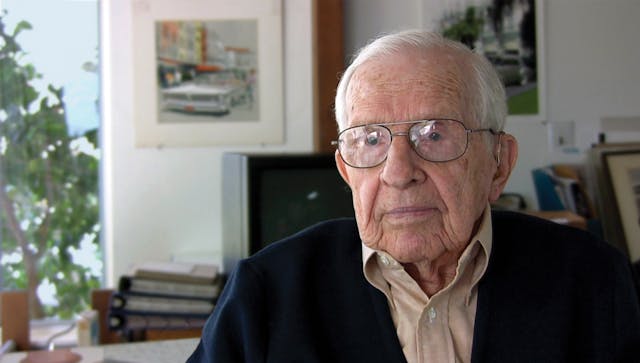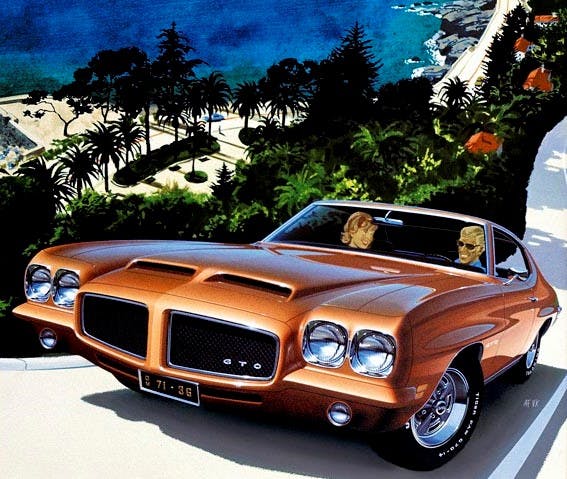Media | Articles
Documentary offers a glimpse at the majesty of Fitz and Van’s iconic car ads

If you love the iconic automotive artwork of Art Fitzpatrick and Van Kaufman, you’ll love a recently released video documentary featuring author Rob Keil’s interviews with the man they called Fitz.
Keil, who wrote a 200-page retrospective about the dynamic duo that was released last fall, had originally planned to use the 2010 interviews in a full-length documentary, but he and Fitzpatrick couldn’t agree on a format. So, years after Fitz died in 2015 (Van passed away in ’95), those conversations became the backbone of Art Fitzpatrick & Van Kaufman: Masters of the Art of Automobile Advertising.
“I knew how I wanted to do the video, but I also wanted to do it the way he wanted—he was my hero,” Keil said of Fitzpatrick in a September 2021 interview. “That didn’t work out, but it evolved into this book, which is the best way to present it anyway.”
Keil decided to edit the Fitzpatrick interviews to create a 12-minute companion video, which was released on Vimeo in May.

“The footage I shot of Fitz back in 2010 (when Fitzpatrick was almost 90) is really special … Hearing the story from him in his own words is a treat, even for those who own the book,” Keil says. “I felt there would be value in making this short documentary available to anyone interested. And for those who don’t know about the book, it’s a nice introduction.
Marketplace
Buy and sell classics with confidence
“I was really lucky to get to know Fitz, and I’m glad I had the foresight to shoot lots of video of him. He was a fascinating character, and his personality shines through nicely in the video.”

With Keil using chapter headings to break up the interview, Fitzpatrick shares the story of his amazing ride from teenage designer to legendary illustrator. Growing up in suburbs of Detroit, he started going to art school, where he became aware that “there was such a thing as designing cars.”
His first job was cutting blueprints at Chrysler Engineering, working the night shift so he could continue attending art school during the day. He later worked at Briggs Manufacturing, which built car bodies for Ford and Chrysler. When Fitzpatrick’s father, also an artist, scored a job at Disney, Fitz went along to California.
“I was driving down Sunset Boulevard one day and I saw this custom-built Packard sitting in front o this shop,” he recalled. “The sign on the building said ‘Darrin of Paris,’ so I stopped, went in, and talked to Dutch Darrin. He hired me on the spot.
“So I spent a year doing cars for (Hollywood legends) Errol Flynn and Al Jolson and Clark Gable. For a 19-year-old from Royal Oak, Michigan, that was a very heady year … It was a lot of fun. I didn’t make much money, but I had a ball.”

Fitz went on to work at Hudson and Packard before the U.S. entered World War II and automakers turned their attention to military production. After joining the Navy, Fitzpatrick worked on warplane engineering and training literature while moonlighting in the advertising industry. By the time he left the military, he’d already secured the Mercury advertising account. It was through Mercury that Fitz was paired with Kaufman, and the rest is history. The two created ads together for Mercury, Buick, Cadillac, and finally Pontiac, where they set the standard. People not only wanted to buy a Pontiac, they wanted to live the lives that were depicted in the ads.
Fitzpatrick says other advertising agencies tried to duplicate the elegant illustrations that he and Kaufman were producing, but “they never understood the key to an emotional, sophisticated approach. It was why we went to European backgrounds. Most of them looked kind of elegant … but what we were really doing was offering something different from the Plaza Hotel in New York (or) the Fontainebleau in Miami, which is where Lincolns and Cadillacs went to get their pictures taken.”
Fitz and Van’s work was definitely different, and the two created an image through art that sold a lot of cars. Keil’s well-crafted video offers a taste of their majesty; don’t be surprised if you go looking for more.



